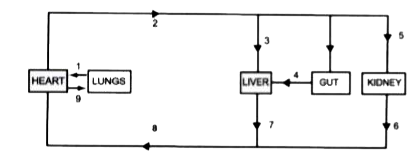End systolic volume of blood is the quantity of blood present
in ventricles after atrial systole
in ventricles after ventricular systole
in ventricles before the opening of semilunar valves
in atria before the closure of AV valves.
The correct Answer is:B
To solve the question regarding the end systolic volume of blood, we will break down the concept step by step.
1. Understanding Cardiac Cycle: The cardiac cycle consists of two main phases: diastole (relaxation) and systole (contraction). During systole, the heart contracts to pump blood out of the ventricles.
2. Atrial Systole: The cycle begins with the contraction of the atria, known as atrial systole. This phase pushes blood into the ventricles.
3. Ventricular Systole: Following atrial systole, the ventricles contract in a phase called ventricular systole. During this phase, the blood is pumped out of the ventricles into the arteries.
4. End Systolic Volume (ESV): After the ventricles have contracted and pumped out blood, there is still some blood remaining in the ventricles. This remaining volume of blood is referred to as the end systolic volume (ESV).
5. Quantity of ESV: The typical quantity of blood that remains in each ventricle after contraction (end systolic volume) is approximately 50 ml.
6. Identifying the Correct Option: The question asks for the location of the end systolic volume. Since ESV is the volume of blood present in the ventricles after ventricular systole, the correct answer is:
- Option B: In ventricles after ventricular systole.
Final Answer:
The end systolic volume of blood is the quantity of blood present in the ventricles after ventricular systole. Therefore, the correct option is B.
---
- Option B: In ventricles after ventricular systole.
The end systolic volume of blood is the quantity of blood present in the ventricles after ventricular systole. Therefore, the correct option is B.
Topper's Solved these Questions
- BODY FLUIDS AND CIRCULATIONBOOK - AAKASH SERIESCHAPTER - BODY FLUIDS AND CIRCULATIONEXERCISE - Exercise -II (Electrocardiagraphy)
2 Videos
- BODY FLUIDS AND CIRCULATIONBOOK - AAKASH SERIESCHAPTER - BODY FLUIDS AND CIRCULATIONEXERCISE - Exercise -II (Double Circulation & Regulation of Cardiac Activity)
2 Videos
- BODY FLUIDS AND CIRCULATIONBOOK - AAKASH SERIESCHAPTER - BODY FLUIDS AND CIRCULATIONEXERCISE - Exercise -II (Human Circulatory System)
10 Videos
- BIOTECHNOLOGY AND ITS APPLICATIONSBOOK - AAKASH SERIESCHAPTER - BIOTECHNOLOGY AND ITS APPLICATIONSEXERCISE - Exercise - III (Previous AIPMT/NEET Questions )
19 Videos
- BREATHING AND EXCHANGE OF GASES BOOK - AAKASH SERIESCHAPTER - BREATHING AND EXCHANGE OF GASES EXERCISE - EXERCISE-III (Previous AIPMT/NEET Questions)
21 Videos
Similar Questions
A small quantity of solution containing Na24 radio nuclide (half−life=15h) of activity 1.0microcurie is injected into the blood of a person. A sample of the blood of volume 1cm3 taken after 5h shows an activity of 296 disintegrations per minute. Determine the total volume of the blood in the body of the person. Assume that the radioactive solution mixes uniformly in the blood of person.
(1 curie =3.7×1010 disintegrations per second)
View SolutionA small quantity of solution containing Na24 radio nuclide (half−life=15h) of activity 1.0microcurie is injected into the blood of a person. A sample of the blood of volume 1cm3 taken after 5h shows an activity of 296 disintegrations per minute. Determine the total volume of the blood in the body of the person. Assume that the radioactive solution mixes uniformly in the blood of person.
(1 curie =3.7×1010 disintegrations per second)
View Solutionred blood cells and white blood cells.
View SolutionThe following simplified diagram refers to the outline plan of the circulation of blood in a mammal, Study the diagram and write the number and the name of the blood vessel in each case as mentioned under.

Which vessel will contain the smallest number of red blood cells per unit volume of blood ?
View SolutionA volume of a healthy human blood is
View SolutionIn the ABO system of blood,group,if both antigens are present but no antibody,the blood group of the individual would be :
View SolutionThe human ciculatory system can be thought of as a closed system of interconnecting pipes through which fluid is continuously circulated by two pumps the two pumps the right and left verticles of the heart, work as simple two-stroke force pumps. The muscles of the heart regulate the force by contracting and relaxing. the contraction (systole) lasts about 0.2s and a complete systole/diastole (contraction/relaxation) cycle lasts about 0.8s. For flood pressures and speeds in the normal range. the volume flow rate of blood through a blood vessel is directly proportional tot he pressure difference over a length of the vessel and to the fourth power of the radius of the vessel. The total mechanical energy per unit volume of blood just as it leaves the heart is E/V=ρgh+P+ρv2
Q. Which of the following is a way to achieve approximately a 45% increase in the volume flow rate of blood through a blood vessel?
View SolutionOpen blood vascular syste is present in
View SolutionAssertion : ADH and RAAS work in response to low blood volume and blood pressure
Reason : ANF works in response to high blood volume and blood pressure.
(a) both are true with reason being correct explanation
(b) both are true but reason is not correct explanation
(c) assertion is true but reason is wrong
(d) both are wrong
View SolutionWhat is the volume of blood that delivers by the renal arteries per minute?
View Solution
